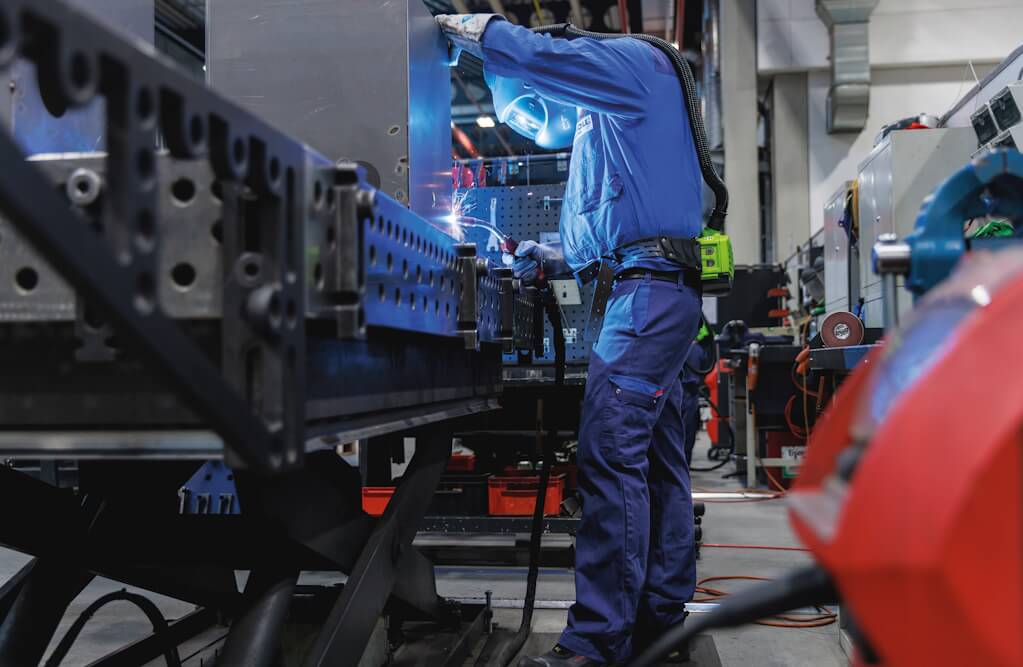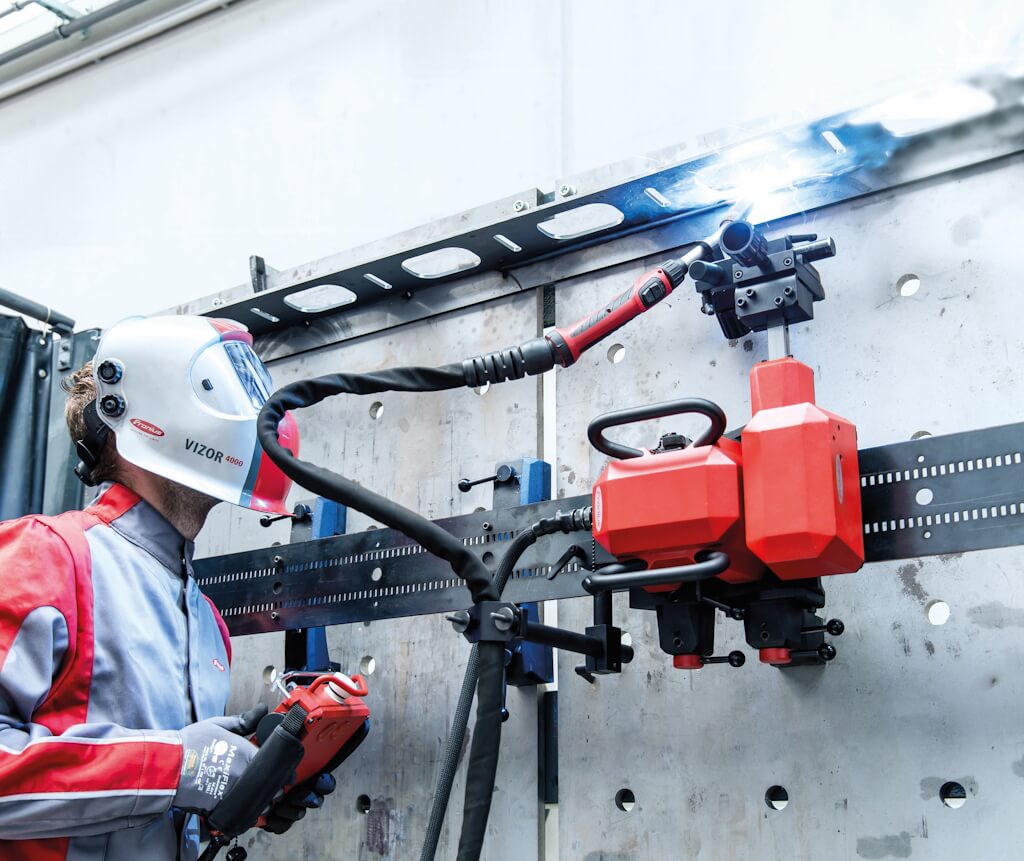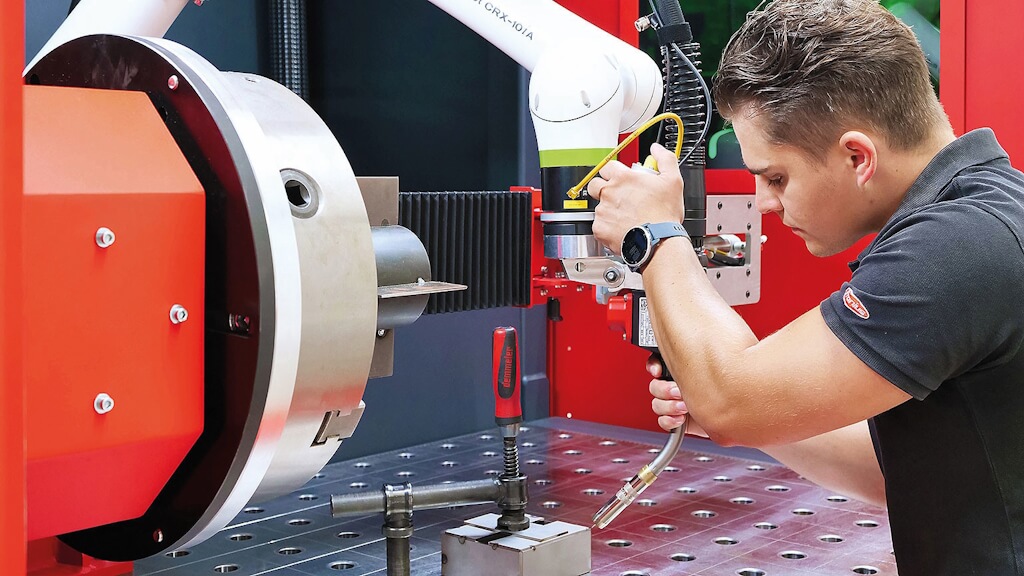Welding is frequently carried out by hand when series production is not a consideration. Welders often work in positions that strain the joints and muscles or adopt awkward postures. This results in complaints such as sprains of the lower back or arms, which not only affect the health of welding professionals but also come at the expense of the company’s productivity. Increasingly, companies are focusing on ergonomics during welding.
Text & images by Fronius International GmbH

Ergonomics has several meanings, one of which is quite literal: the term is derived from the Greek words “ergon” and “nomos”. As “ergon” means work and “nomos” translates as law, the word ergonomics can be translated as “law of work”. Another significant (and practical) definition of the term “ergonomics” is the mutual adaptation of people and their working conditions. Ergonomists try to design the workplace in such a way that it does not impair the physical or mental health of workers.
The same applies to welding workplaces. “These should be designed to meet the physical requirements of welders and enable predominantly focused work that does not cause fatigue,” emphasizes Peter Fronius, Head of Strategic Product Management Professional Welding Tools. “For example, by taking the height or arm reach of the welders into account.
If workplaces do not satisfy ergonomic standards, the likelihood of sickness, injury, and absence through illness increases.” Of course, ergonomic risk factors cannot be eliminated every time and everywhere. This is the case for out-of-position welding, for example, whereby the aim must be to limit the time that the individual spends in the situation insofar as possible.
Risk factors when welding
Most causes of injury are not restricted to specific industries but result from welders’ movement and behavior patterns. Typical here are repeatedly stretching the body, twisting the spine, being supported by or kneeling on hard surfaces, maintaining the same posture over a longer period of time, or a lack of rest. If such risk factors occur repeatedly (individually or in combination), they can lead to work-related musculoskeletal disorders (MSDs); injuries and diseases that affect muscles, nerves, tendons, ligaments, joints, intervertebral discs, skin, subcutaneous tissue, blood vessels, or bones. In addition, unfavorable environmental conditions such as extreme temperatures can also contribute to the development of MSDs, while personal risk factors such as physical condition, pre-existing illnesses, or age also come into play.

Work-related musculoskeletal disorders in welders
MSDs usually develop due to micro-traumas acting on the body over time and causing conditions such as lumbar slipped discs—the most common herniated discs due to the overall weight of the spine sitting most heavily on the two lower discs. These intervertebral discs consist of flexible, annular cartilage that contains semi-liquid gel. If a welder repeatedly lifts heavy components while adopting an unfavorable posture, this cartilage can degrade and tear over time. This results in the intervertebral disc bulging, pressing on a spinal nerve, and causing severe pain.
The most common musculoskeletal disorders include back injuries, bursitis, inflammation of the tendon and tendon sheath, carpal tunnel syndrome, and thoracic outlet syndrome. This disorder, which can occur due to compression of nerves, arteries, or large veins in the neck and chest area, is very painful and can be caused by frequent overhead welding.

Ergonomics and welding are not contradictory
Welders may be forced to adopt unfavorable postures for a variety of tasks – frequently over long periods. It is often easier for the welder to move around large, heavy components than to move the component into the optimum welding position. Is it therefore paradoxical to talk about ergonomics and welding in the same sentence? Absolutely not. Because despite all the hindrances, there are plenty of ways welding companies can design workplaces and work equipment ergonomically. Effort that is generally rewarded by a healthier workforce, better morale, higher productivity, and enhanced product quality. For example, height-adjustable welding tables and stools are tried and tested means of adapting the welding height to the physical requirements of welders.
Welding cartridges
“Rather than welding meters of welds by hand in the overhead position, rail-guided welding carriages can often be used. The same applies to longitudinal seams and circumferential welds of large dimensions, which can be joined either with rail-guided carriages or magnetic welding carriages. With these mechanized systems, welders essentially only have to operate the remote control, while standing upright and with no physical exertion,” explains Christian Neuhofer, Product Manager Fronius Welding Automation.

Welding 24/7 without physical effort
Nowadays, cobot welding cells mean that automated welding, even of small batch sizes, is cost-effective. Thanks to its enormous flexibility for joining different components, the compact CWC-S from Fronius is the ideal tool for this. “It is easy to use, even without programming knowledge, and there is no physical effort required,” Neuhofer continues: “Your software remembers the welding sequences of the individual components, which are mounted either on a welding table or turn-tilt positioner. The components are welded fully autonomously in a protective cabin with an automatically closing and opening glare protection screen, which protects the welder from arc radiation—around the clock if necessary.”
Heavy components should be lifted while fastened to lifting aids, such as indoor cranes, to protect the muscles and spine. This rule applies to all lifting activities related to welding, because overloading the musculoskeletal system not only endangers health in the long term but can also result in instant injuries such as lumbar syndrome, also commonly referred to as lumbago.
Orbital systems relieve the spine
Pipelines that are often used in the food industry or in power plant construction are produced using orbital welding, whereby the welding torch is guided around the pipe. They often have to be joined at unfavorable heights and positions, which can have an adverse effect on the welder’s back. Orbital systems, such as the open and closed welding heads from Fronius, provide a solution. If the pipe to be joined is clamped, the welding torch automatically moves around the component and welds the seam with consistently high quality.

Ergonomics a priority
The products of the Austrian technology pioneer have made a name for themselves not only for their technological finesse, but also for their user-friendliness. All welding torches, for example, are characterized by their low weight, comfortable handles, and user interfaces adapted to the tasks at hand. The ergonomic handles with non-slip components fit comfortably in the hand during welding and allow for safe and simple welding torch guidance, with ball joints facilitating optimum torch adjustment. Furthermore, the weight distribution of all torch components is well-balanced, which promotes fatigue-free welding.
Modularity combined with personal configuration and intuitive operating procedures are the keywords that we always focus on with our welding systems. The easier they are to use, the better professional welders can concentrate on the welding task at hand and keep their risk of injury low. In summary, there are many ways to make the working environment of professional welders as safe and ergonomic as possible, and in doing so, positively influence the working conditions and motivation of employees. This in turn enhances not only cost effectiveness for the company but also public perception.
About Fronius
Fronius has over 7,000 employees worldwide, a current export share of 87%, and 1446 active patents. Founded in 1945 as a regional one-man operation, today the company is a global player with 37 international subsidiaries and a network of sales partners in more than 60 countries. The family-owned company from Austria is active in photovoltaics, welding, and battery charging technology. For information, visit Fronius.com

